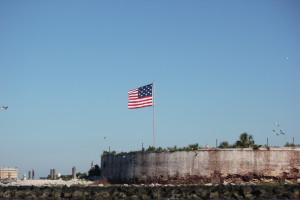Here are some facts about this flag:
- The Original was made in Baltimore, Maryland, in July-August 1813 by flagmaker Mary Pickersgill
- Commissioned by Major George Armistead, commander of Fort McHenry
- Original size: 30 feet by 42 feet
- Fifteen stars and fifteen stripes
- Also known as the Great Garrison Flag
- Raised over Fort McHenry on the morning of September 14, 1814, to signal American victory over the British in the Battle of Baltimore; the sight inspired Francis Scott Key to write “The Star-Spangled Banner”
- Preserved by the Armistead family as a memento of the battle
The making of the Star Spangled Banner
In June 1813, Major George Armistead arrived in Baltimore, Maryland, to take command of Fort McHenry, built to guard the water entrance to the city. Armistead commissioned Mary Pickersgill, a Baltimore flag maker, to sew two flags for the fort: a smaller storm flag (17 by 25 ft) and a larger garrison flag (30 by 42 ft). She was hired under a government contract and was assisted by her daughter, two nieces, and an indentured African-American girl.
The larger of these two flags would become known as the “Star-Spangled Banner.” Pickersgill stitched it from a combination of dyed English wool bunting (red and white stripes and blue union) and white cotton (stars). Each star is about two feet in diameter, each stripe about 24 inches wide. The Star-Spangled Banner’s impressive scale (about one-fourth the size of a modern basketball court) reflects its purpose as a garrison flag. It was intended to fly from a flagpole about ninety feet high and be visible from great distances. At its original dimensions of 30 by 42 feet, it was larger than the modern garrison flags used today by the United States Army, which have a standard size of 20 by 38 feet.
The first Flag Act, adopted on June 14, 1777, created the original United States flag of thirteen stars and thirteen stripes. The Star-Spangled Banner has fifteen stars and fifteen stripes as provided for in the second Flag Act approved by Congress on January 13, 1794. The additional stars and stripes represent Vermont (1791) and Kentucky (1792) joining the Union. (The third Flag Act, passed on April 4, 1818, reduced the number of stripes back to thirteen to honor the original thirteen colonies and provided for one star for each state — a new star to be added to the flag on the Fourth of July following the admission of each new state.) Pickersgill spent between six and eight weeks making the flags, and they were delivered to Fort McHenry on August 19, 1813. The government paid $405.90 for the garrison flag and $168.54 for the storm flag. The garrison flag would soon after be raised at Fort McHenry and ultimately find a permanent home at the Smithsonian Institution’s National Museum of American History. The whereabouts of the storm flag are not known.


I have copies of my 4x great grandfather’s letters to his wife and children while stationed on Pinckney island 1863 until surrender. He was starving, so sad to read. I would like to send a copy of these letters to you. Please contact me by email.